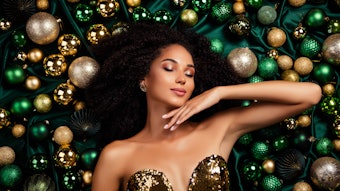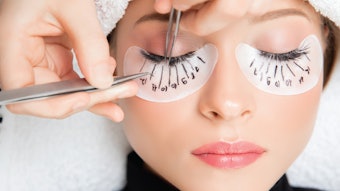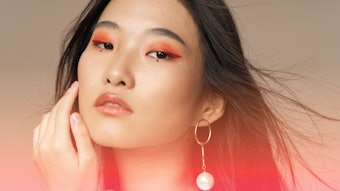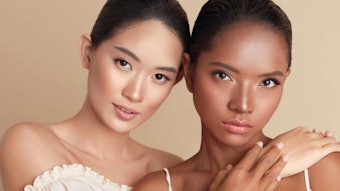Global color cosmetics sales reached $36.8 billion in 2007, according to Euromonitor International’s provisional 2008 data, representing an approximate 5% rise on the 2006 figure (in USD fixed exchange rate, current terms). While a seemingly healthy increase, cosmetics and toiletries are typically strong performers within the FMCG (fast-moving consumer goods) market, and, compared to other beauty categories, color cosmetics lag behind the average. In fact, Euromonitor International’s provisional figures suggest only the commoditized bath and shower category and depilatories, which faces stiff salon competition in many markets, recorded lower growth in 2007.
Category Leaders
Eye makeup, worth $10.1 billion, was the engine of dynamism in the global color cosmetics market during 2002–2006, and enjoyed a further year of category-leading growth of 6% in 2007, according to provisional Euromonitor International data. Dramatic, smoky eyes combined with nude lips, the “mod” look, dominated makeup trends across Western markets and continues to propel the sector. In addition, mascara is an important focus for innovation within the wider category. Meanwhile, facial makeup, which at $13.2 billion is the largest color cosmetics sector, showed the weakest performance in 2007. Not even a growing demand for blusher and bronzers was enough to offset the slowdown in the maturing foundation market.
Within the $10.1 billion lip products sector, lip gloss has been the champion of growth, with year-on-year increases of 9% between 2002–2006—approximately twice the level achieved by lipstick. Followers of the mod trend often opt for a sheer, glossy finish over the heavy matte coverage of a lipstick. In 2007, however, the market saw a resurgence in lipstick sales, and emerging markets are behind this growth.
Far from saturated and with large populations and dynamic economies, Eastern Europe and Latin America are propelling sales across the lip products sector. Since the mod look holds less sway in these regions, lipstick has become an important beneficiary of this growth. To a lesser extent, the Western markets are also contributing to a lipstick revival. In its latest incarnation, the mod trend calls for brighter, bolder lip colors, and some makeup firms are poised to tap into this new demand—PPR’s YSL Beauté, for example, launched Lip Twins, a lipstick/gloss duo, in early 2007.
At $3.5 billion, nail products is the smallest color cosmetics sector, and except for the booming demand for strengthening treatments, it holds the least promise for cosmetics firms.
Growth Slows in the Developed Markets
Emerging markets are injecting vibrancy into the global color cosmetics category. In terms of annual spending per woman, Eastern Europe and Latin America have seen growth of 78% and 55%, respectively, according to new provisional figures, albeit from a base well below the key value markets of North America and Western Europe. The Asia-Pacific markets of China and India are also becoming important sources of growth. China’s color cosmetics market will expand by almost $600 million through 2012, and India’s sales growth is predicted to be 19% annually over the same period. The global average for 2007–2012 is forecast to be closer to 2% per year.
The picture is less positive in the more developed markets. Euromonitor International’s provisional data shows sales of color cosmetics have declined every year for the last three in the U.S., and of Europe’s largest markets, only Spain and the U.K. achieved year-on-year growth during 2002–2007. Yet color cosmetics is one of the beauty market’s most innovative categories, and new product development is helping to lift unit prices and encourage limited volume growth in many developed markets.
Natural Ingredients vs. High-performance Technology
Natural ingredients, so central in driving up value in categories such as skin care and bath/shower products, have found their way into color cosmetics, and are offering women a range of added benefits aside from chemical-free formulations. Mineral makeup, for example, delivers important nutrients to the skin, provides a natural sunscreen, affords long-lasting coverage and is suitable for sensitive skin types. Bare Escentuals, a pioneer in mineral makeup, saw sales reach almost $400 million in 2006, although its market niche is increasingly being penetrated by the big name brands. Maybelline, L’Oréal Paris, Revlon and Almay are just some of the mainstream labels that have launched mineral makeup lines, and private label presence is also growing.
At the other end of the spectrum, some manufacturers are taking the high-tech approach in an attempt to satisfy demand for professional results that can be achieved at home. A new generation of makeup has emerged—tapping industries as diverse as Japanese printing, lighting and satellites in the pursuit of trendsetting products. Examples include Chanel’s limited edition Duo Platinum Holographic nail polish, which took inspiration from NASA’s satellite technology, and Givenchy’s Rouge Interdit, which incorporates the same liquid-crystal technology used to create a 3-D effect in plasma TVs. Dior’s Backstage collection is one of the most innovative ranges, featuring high concentrations of pigment, interesting textures and know-how borrowed from the toy manufacturing, food processing and car paint industries to allow home-based products to emulate the effects achieved
by makeup artists
To continue reading this article, please click here. You will be redirected to GCI magazine's Web site.










